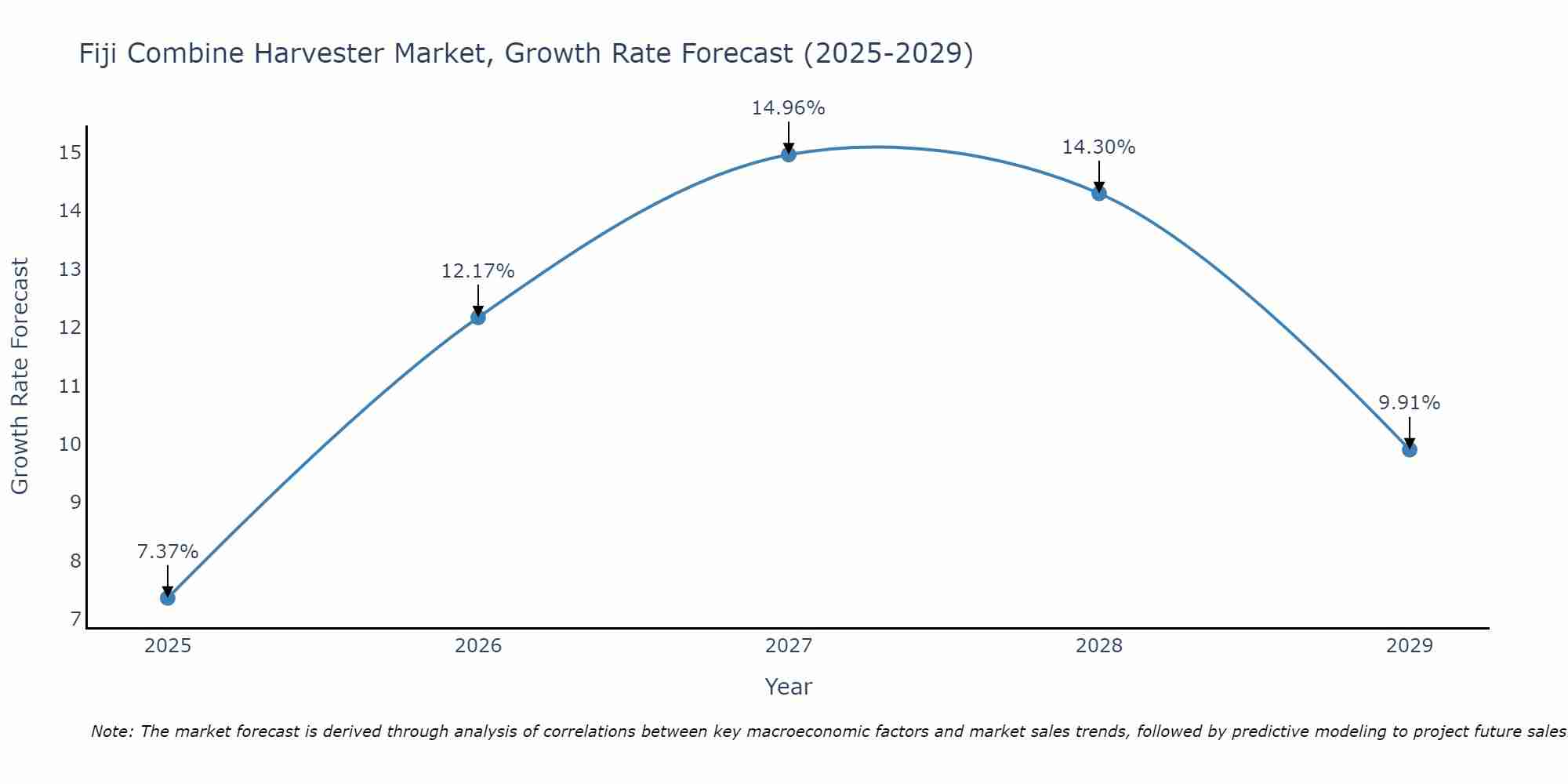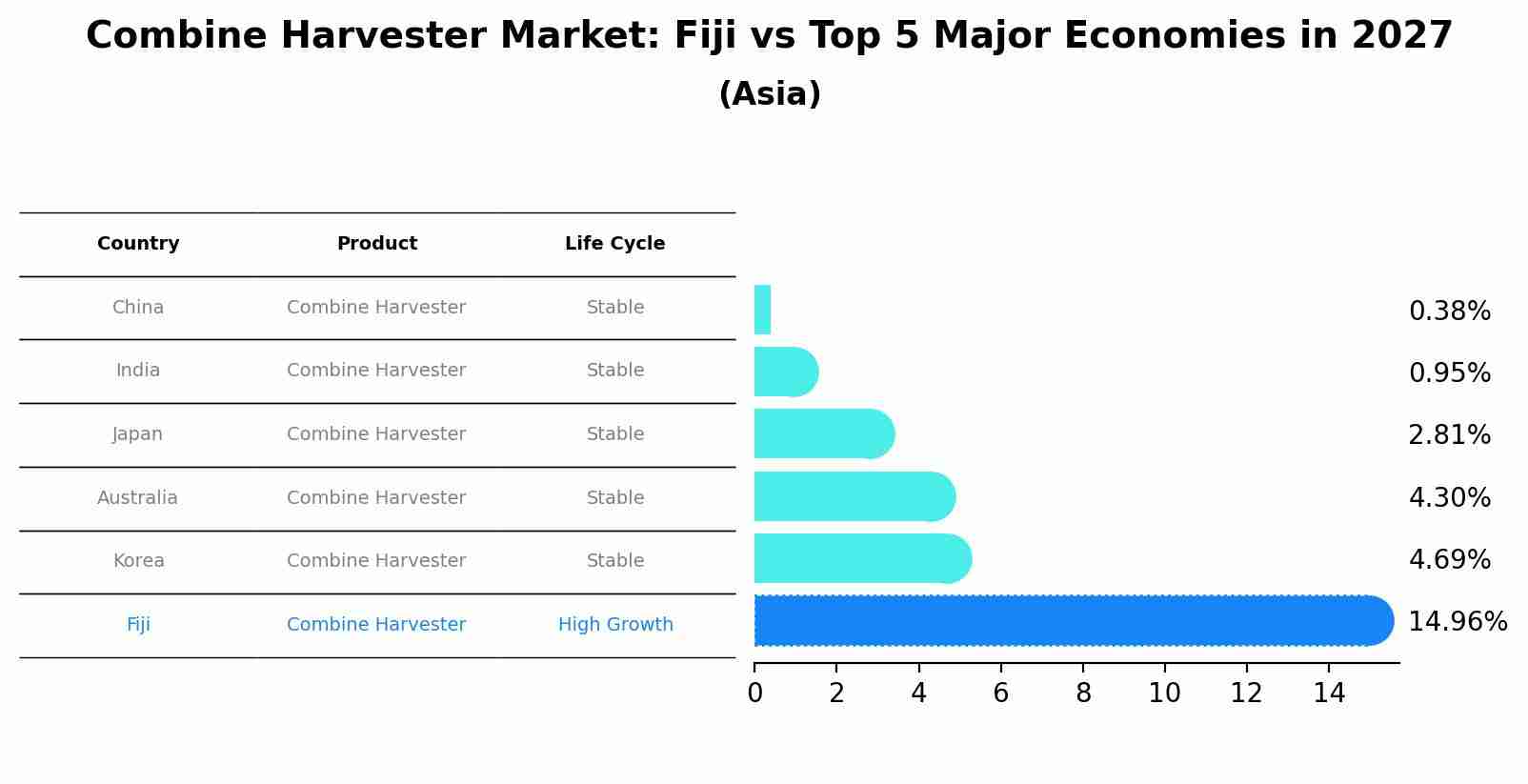Fiji Combine Harvester Market (2025-2031) | Companies, Industry, Forecast, Share, Revenue, Size, Analysis, Trends, Growth, Outlook, Segmentation & Value
| Product Code: ETC5398238 | Publication Date: Nov 2023 | Updated Date: Oct 2025 | Product Type: Market Research Report | |
| Publisher: 6Wresearch | Author: Bhawna Singh | No. of Pages: 60 | No. of Figures: 30 | No. of Tables: 5 |
Fiji Combine Harvester Market Size Growth Rate
The Fiji Combine Harvester Market is projected to witness mixed growth rate patterns during 2025 to 2029. Growth accelerates to 14.96% in 2027, following an initial rate of 7.37%, before easing to 9.91% at the end of the period.

Combine Harvester Market: Fiji vs Top 5 Major Economies in 2027 (Asia)
Fiji's Combine Harvester market is anticipated to experience a high growth rate of 14.96% by 2027, reflecting trends observed in the largest economy China, followed by India, Japan, Australia and South Korea.

Fiji Combine Harvester Market Overview
The combine harvester market in Fiji is growing as the agricultural sector seeks to increase productivity and efficiency. Combine harvesters are essential machines in the harvesting of cereal crops, reducing labor costs and improving yield. As agriculture in Fiji continues to modernize, particularly with a focus on export-oriented crops like sugarcane and rice, the demand for combine harvesters is expected to rise. This growth will be fueled by the governments push to improve farming practices and mechanize the agricultural processes.
Drivers of the market
The combine harvester market in Fiji is driven by the increasing demand for efficient agricultural equipment. As the agricultural sector continues to modernize, there is a push for machinery that can improve crop yield, reduce labor costs, and enhance productivity, making combine harvesters a critical tool for farmers.
Challenges of the market
The combine harvester market in Fiji faces challenges due to the limited size of the countrys agricultural sector, which reduces the demand for large-scale farming equipment. High upfront costs and the need for specialized maintenance services also pose barriers to adoption, particularly for smaller farms. Additionally, the lack of local suppliers for spare parts and technical support makes it difficult for farmers to maintain and operate such equipment efficiently.
Government Policy of the market
The combine harvester market in Fiji is influenced by government agricultural policies aimed at modernizing the countrys farming sector and increasing productivity. Policies that promote sustainable agricultural practices and technological adoption in the farming community are likely to drive demand for modern farming equipment such as combine harvesters. Additionally, government support for improving food security, enhancing crop yield, and investing in rural development initiatives fosters a favorable environment for the growth of the combine harvester market. With the government encouraging the mechanization of agriculture, Fijis farmers are increasingly adopting advanced harvesting solutions to improve efficiency and reduce labor costs.
Key Highlights of the Report:
- Fiji Combine Harvester Market Outlook
- Market Size of Fiji Combine Harvester Market, 2024
- Forecast of Fiji Combine Harvester Market, 2031
- Historical Data and Forecast of Fiji Combine Harvester Revenues & Volume for the Period 2021-2031
- Fiji Combine Harvester Market Trend Evolution
- Fiji Combine Harvester Market Drivers and Challenges
- Fiji Combine Harvester Price Trends
- Fiji Combine Harvester Porter`s Five Forces
- Fiji Combine Harvester Industry Life Cycle
- Historical Data and Forecast of Fiji Combine Harvester Market Revenues & Volume By Cutting Width for the Period 2021-2031
- Historical Data and Forecast of Fiji Combine Harvester Market Revenues & Volume By Small Size Combine Harvester for the Period 2021-2031
- Historical Data and Forecast of Fiji Combine Harvester Market Revenues & Volume By Large Size Combine Harvester for the Period 2021-2031
- Historical Data and Forecast of Fiji Combine Harvester Market Revenues & Volume By Type for the Period 2021-2031
- Historical Data and Forecast of Fiji Combine Harvester Market Revenues & Volume By Wheel Type Combine Harvester for the Period 2021-2031
- Historical Data and Forecast of Fiji Combine Harvester Market Revenues & Volume By Crawler Type Combine Harvester for the Period 2021-2031
- Historical Data and Forecast of Fiji Combine Harvester Market Revenues & Volume By Power Source for the Period 2021-2031
- Historical Data and Forecast of Fiji Combine Harvester Market Revenues & Volume By Tractor Pulled/PTO Powered Combine Harvester for the Period 2021-2031
- Historical Data and Forecast of Fiji Combine Harvester Market Revenues & Volume By Self-Propelled Combine Harvester for the Period 2021-2031
- Fiji Combine Harvester Import Export Trade Statistics
- Market Opportunity Assessment By Cutting Width
- Market Opportunity Assessment By Type
- Market Opportunity Assessment By Power Source
- Fiji Combine Harvester Top Companies Market Share
- Fiji Combine Harvester Competitive Benchmarking By Technical and Operational Parameters
- Fiji Combine Harvester Company Profiles
- Fiji Combine Harvester Key Strategic Recommendations
Frequently Asked Questions About the Market Study (FAQs):
1 Executive Summary |
2 Introduction |
2.1 Key Highlights of the Report |
2.2 Report Description |
2.3 Market Scope & Segmentation |
2.4 Research Methodology |
2.5 Assumptions |
3 Fiji Combine Harvester Market Overview |
3.1 Fiji Country Macro Economic Indicators |
3.2 Fiji Combine Harvester Market Revenues & Volume, 2021 & 2031F |
3.3 Fiji Combine Harvester Market - Industry Life Cycle |
3.4 Fiji Combine Harvester Market - Porter's Five Forces |
3.5 Fiji Combine Harvester Market Revenues & Volume Share, By Cutting Width, 2021 & 2031F |
3.6 Fiji Combine Harvester Market Revenues & Volume Share, By Type, 2021 & 2031F |
3.7 Fiji Combine Harvester Market Revenues & Volume Share, By Power Source, 2021 & 2031F |
4 Fiji Combine Harvester Market Dynamics |
4.1 Impact Analysis |
4.2 Market Drivers |
4.2.1 Government subsidies and support for agriculture mechanization in Fiji. |
4.2.2 Increasing demand for efficient farming equipment to improve productivity. |
4.2.3 Growing awareness among farmers about the benefits of using combine harvesters. |
4.3 Market Restraints |
4.3.1 High initial investment cost of combine harvesters. |
4.3.2 Limited availability of skilled operators for operating the machinery. |
4.3.3 Lack of proper infrastructure for maintenance and repair services. |
5 Fiji Combine Harvester Market Trends |
6 Fiji Combine Harvester Market Segmentations |
6.1 Fiji Combine Harvester Market, By Cutting Width |
6.1.1 Overview and Analysis |
6.1.2 Fiji Combine Harvester Market Revenues & Volume, By Small Size Combine Harvester, 2021-2031F |
6.1.3 Fiji Combine Harvester Market Revenues & Volume, By Large Size Combine Harvester, 2021-2031F |
6.2 Fiji Combine Harvester Market, By Type |
6.2.1 Overview and Analysis |
6.2.2 Fiji Combine Harvester Market Revenues & Volume, By Wheel Type Combine Harvester, 2021-2031F |
6.2.3 Fiji Combine Harvester Market Revenues & Volume, By Crawler Type Combine Harvester, 2021-2031F |
6.3 Fiji Combine Harvester Market, By Power Source |
6.3.1 Overview and Analysis |
6.3.2 Fiji Combine Harvester Market Revenues & Volume, By Tractor Pulled/PTO Powered Combine Harvester, 2021-2031F |
6.3.3 Fiji Combine Harvester Market Revenues & Volume, By Self-Propelled Combine Harvester, 2021-2031F |
7 Fiji Combine Harvester Market Import-Export Trade Statistics |
7.1 Fiji Combine Harvester Market Export to Major Countries |
7.2 Fiji Combine Harvester Market Imports from Major Countries |
8 Fiji Combine Harvester Market Key Performance Indicators |
8.1 Average utilization rate of combine harvesters in Fiji. |
8.2 Adoption rate of precision farming techniques in conjunction with combine harvesters. |
8.3 Percentage increase in agricultural yield attributed to the use of combine harvesters. |
9 Fiji Combine Harvester Market - Opportunity Assessment |
9.1 Fiji Combine Harvester Market Opportunity Assessment, By Cutting Width, 2021 & 2031F |
9.2 Fiji Combine Harvester Market Opportunity Assessment, By Type, 2021 & 2031F |
9.3 Fiji Combine Harvester Market Opportunity Assessment, By Power Source, 2021 & 2031F |
10 Fiji Combine Harvester Market - Competitive Landscape |
10.1 Fiji Combine Harvester Market Revenue Share, By Companies, 2024 |
10.2 Fiji Combine Harvester Market Competitive Benchmarking, By Operating and Technical Parameters |
11 Company Profiles |
12 Recommendations | 13 Disclaimer |
- Single User License$ 1,995
- Department License$ 2,400
- Site License$ 3,120
- Global License$ 3,795
Search
Thought Leadership and Analyst Meet
Our Clients
Related Reports
- Germany Breakfast Food Market (2026-2032) | Industry, Share, Growth, Size, Companies, Value, Analysis, Revenue, Trends, Forecast & Outlook
- Australia Briquette Market (2025-2031) | Growth, Size, Revenue, Forecast, Analysis, Trends, Value, Share, Industry & Companies
- Vietnam System Integrator Market (2025-2031) | Size, Companies, Analysis, Industry, Value, Forecast, Growth, Trends, Revenue & Share
- ASEAN and Thailand Brain Health Supplements Market (2025-2031) | Strategy, Consumer Insights, Analysis, Investment Trends, Opportunities, Growth, Size, Share, Industry, Revenue, Segments, Value, Segmentation, Supply, Forecast, Restraints, Outlook, Competition, Drivers, Trends, Demand, Pricing Analysis, Competitive, Strategic Insights, Companies, Challenges
- ASEAN Bearings Market (2025-2031) | Strategy, Consumer Insights, Analysis, Investment Trends, Opportunities, Growth, Size, Share, Industry, Revenue, Segments, Value, Segmentation, Supply, Forecast, Restraints, Outlook, Competition, Drivers, Trends, Demand, Pricing Analysis, Competitive, Strategic Insights, Companies, Challenges
- Europe Flooring Market (2025-2031) | Outlook, Share, Industry, Trends, Forecast, Companies, Revenue, Size, Analysis, Growth & Value
- Saudi Arabia Manlift Market (2025-2031) | Outlook, Size, Growth, Trends, Companies, Industry, Revenue, Value, Share, Forecast & Analysis
- Uganda Excavator, Crane, and Wheel Loaders Market (2025-2031) | Strategy, Consumer Insights, Analysis, Investment Trends, Opportunities, Growth, Size, Share, Industry, Revenue, Segments, Value, Segmentation, Supply, Forecast, Restraints, Outlook, Competition, Drivers, Trends, Demand, Pricing Analysis, Competitive, Strategic Insights, Companies, Challenges
- Rwanda Excavator, Crane, and Wheel Loaders Market (2025-2031) | Strategy, Consumer Insights, Analysis, Investment Trends, Opportunities, Growth, Size, Share, Industry, Revenue, Segments, Value, Segmentation, Supply, Forecast, Restraints, Outlook, Competition, Drivers, Trends, Demand, Pricing Analysis, Competitive, Strategic Insights, Companies, Challenges
- Kenya Excavator, Crane, and Wheel Loaders Market (2025-2031) | Strategy, Consumer Insights, Analysis, Investment Trends, Opportunities, Growth, Size, Share, Industry, Revenue, Segments, Value, Segmentation, Supply, Forecast, Restraints, Outlook, Competition, Drivers, Trends, Demand, Pricing Analysis, Competitive, Strategic Insights, Companies, Challenges
Industry Events and Analyst Meet
Whitepaper
- Middle East & Africa Commercial Security Market Click here to view more.
- Middle East & Africa Fire Safety Systems & Equipment Market Click here to view more.
- GCC Drone Market Click here to view more.
- Middle East Lighting Fixture Market Click here to view more.
- GCC Physical & Perimeter Security Market Click here to view more.
6WResearch In News
- Doha a strategic location for EV manufacturing hub: IPA Qatar
- Demand for luxury TVs surging in the GCC, says Samsung
- Empowering Growth: The Thriving Journey of Bangladesh’s Cable Industry
- Demand for luxury TVs surging in the GCC, says Samsung
- Video call with a traditional healer? Once unthinkable, it’s now common in South Africa
- Intelligent Buildings To Smooth GCC’s Path To Net Zero


















